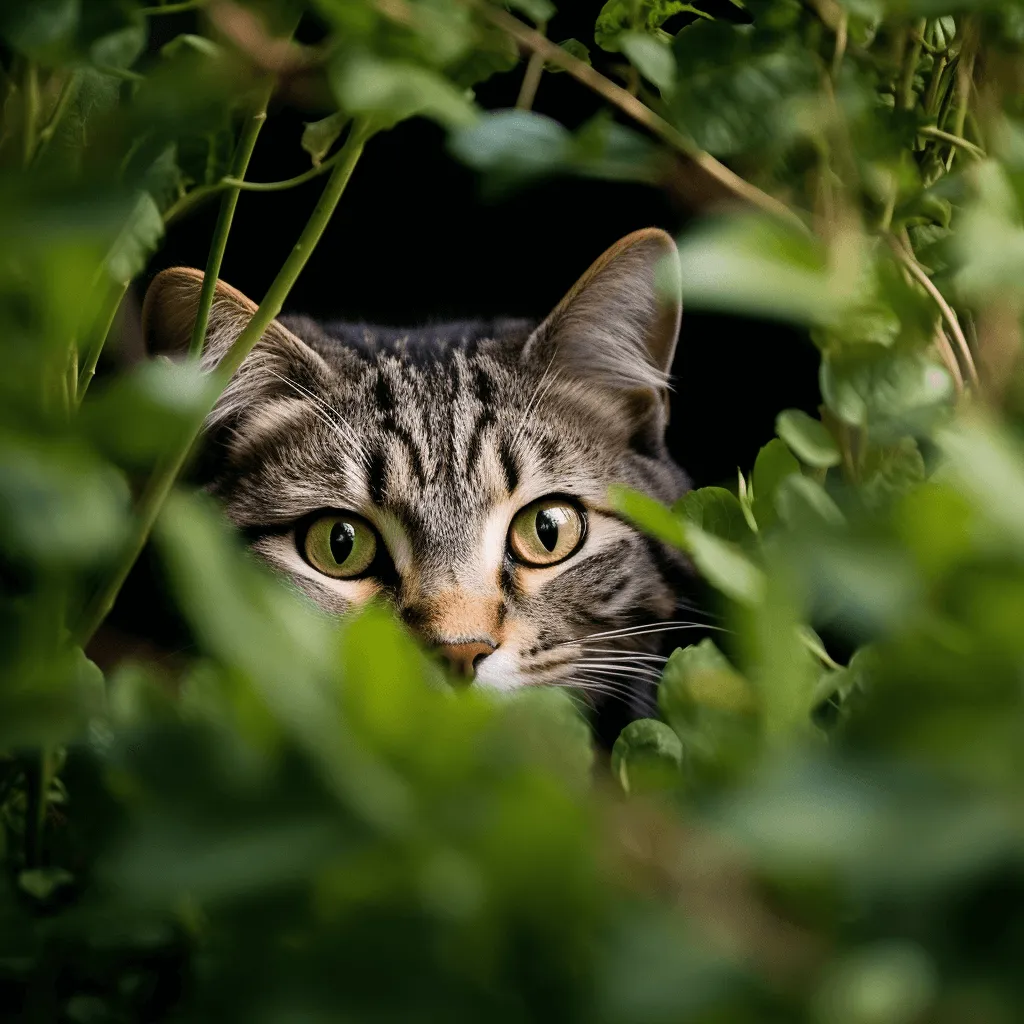Signs Of A Scared Cat
Recognizing signs of fear in your cat is crucial for understanding its emotional state. While some cats may openly show that they are afraid, others can hide their discomfort, making it harder to notice. It's important to be aware of the following signs that indicate fear in cats:
- Freezing in place or crouching low to the ground, trying to make themselves small
- Running away or seeking hiding spots
- Arching their back and puffing up their fur
- Wide eyes with dilated pupils shaped like ovals or circles
- Tucking their tail under or rapidly swishing the tip from side to side
- Rapid ear movements or flattening their ears against their head
- Hissing or spitting as a defensive response
- Scratching or biting when feeling threatened
- Eliminating outside their litter tray, such as peeing or pooping
If you observe any of these signs, it's likely your cat is experiencing fear, anxiety, or stress. It's important to take the necessary steps to help it feel safe and secure again. Additionally, if you notice symptoms like pain, blood in the urine, or signs of stress cystitis, a condition that can be triggered by anxiety, contact your vet promptly for assistance and guidance.
How Long Will A Cat Hide If Scared
The duration of how long a cat will hide when afraid can vary depending on several factors. Each cat has its own unique personality and coping mechanisms, so there is no set time frame for its behavior. Some cats may only hide for a few hours, while others may stay hidden for days or even longer. It's essential to create a calm and secure environment for your scared cat, providing it with hiding places, such as cozy beds or secluded areas, where it feels safe. Avoid forcing it to come out or trying to lure it out forcefully, as it may increase the anxiety. Be patient and give your cat time to come out on its own terms. Offer gentle reassurance, provide food and water near its hiding spot, and create a peaceful atmosphere to help regain confidence. If its hiding behavior persists for an extended period or you notice any other concerning signs, it's advisable to consult with a veterinarian or a professional cat behaviorist for further guidance.

How Do I Find Out What Is Frightening My Cat?
If you suspect that specific phobias may be causing fear in your cat, try to identify the potential triggers. These can include loud noises like thunderstorms or fireworks, certain objects or people, unfamiliar environments, or interactions with other animals. By closely monitoring your cat's reactions and noting any patterns, you may be able to pinpoint the sources of the cat’s fear.
It's important to remember that each cat is unique, and their fears and phobias may vary. Once you have identified potential triggers, you can work on desensitization techniques to help your cat overcome its fears gradually.
If you find it challenging to determine the exact cause of your cat's fear or if its phobias are severe, it's advisable to consult with a veterinarian or a professional animal behaviorist. They can provide further guidance and recommend appropriate strategies or, in some cases, medications to help alleviate your cat's anxiety and fear.

What Can I Do To Help When My Cat Is Scared Or Anxious?
Observe your cat's behavior: Pay close attention to your cat's body language and reactions in different situations. Notice any sudden changes in behavior, such as hiding, excessive grooming, hissing, or avoiding certain areas of your home. These signs can indicate that something is causing fear or stress.
Eliminate potential triggers: Create a calm and secure environment for your cat by removing any possible sources of fear. This may include loud noises, unfamiliar people or animals, or sudden changes in their surroundings. By eliminating these triggers, you can narrow down the possible causes of their fear.
Gradual exposure and desensitization: If you suspect a specific trigger, such as a noise or object, try gradually exposing your cat to it in a controlled and positive manner. Start at a distance and gradually decrease the distance over time, rewarding your cat with treats or praise for calm behavior. This process, known as desensitization, can help your cat overcome their fear gradually.
Consult with a veterinarian or behaviorist: If you're unable to determine the source of your cat's fear or if their anxiety persists, it may be beneficial to seek professional advice. A veterinarian or cat behaviorist can assess your cat's behavior and provide guidance.
Respect Your Cat’s Space
Respecting your cat's space is crucial for its well-being and overall comfort. While it may be tempting to pick up or cuddle a frightened cat, it's important to resist that urge.
Forcing interactions on a nervous cat can be counterproductive and lead to further distress. Giving your cat space is key – never underestimate the power of providing them with their own personal area.
When you have visitors, it's best to allow your cat to decide when and if it wants to socialize. Ensure your cat has a safe place to retreat to – a room with food, water, a cozy resting spot, and a litter box will provide it with the security it craves.
Respecting your cat's need for space helps prevent unnecessary conflicts and allows it to feel secure in its environment. By providing it with their own designated areas and avoiding forced interactions, you create an atmosphere that fosters its well-being.
Be Patient As Your Cat Recovers
Recovery from a stressful event can vary for each cat, and it's important to be patient as it regains its sense of safety and security. Whether it was a sudden loud noise, an overwhelming interaction, or a territorial encounter that frightened it, giving your cat time to recover is crucial.
Create a calm and quiet environment for your cat to retreat to, allowing it to feel safe in its own space. If your cat feels comfortable with you, simply sit quietly nearby and give it the space.
Remember, cats have their own unique timelines and ways of processing their emotions. It may take hours or even days for them to fully recover and return to their normal behavior. Respect their boundaries and let them come to you on their own terms.

Try To Minimize The Things That Scare Them
Creating a safe and comfortable environment for your cat is essential, and minimizing the things that scare them can make a big difference. Identify the triggers that cause fear or anxiety in your cat and take steps to reduce its exposure to those triggers.
For example, if your cat is afraid of loud household appliances like the vacuum cleaner, try to schedule their use when your cat is outside or confine them to another room with the door closed. This way, the noise won't be as overwhelming for your cat.
While it's important not to tip-toe around your cat constantly, being mindful of their sensitivities can help create a more harmonious living environment. By understanding its triggers, you can make adjustments to minimize their impact and help your cat feel more at ease.
Consider investing in a microchip cat flap, which allows your cat to have controlled access to the outdoors. This can provide it with an escape route when it needs to retreat from loud noises inside the house, giving it a sense of security and control.
Introduce New Things Slowly
It's important to recognize that cats are sensitive creatures and may have performance anxiety when faced with unfamiliar circumstances. By introducing new things slowly, you allow your cat to adjust at its own pace and build trust in its environment. During the introduction process, provide a calm and quiet space where your cat can retreat to if it feels overwhelmed. Offer positive reinforcement and rewards when it shows curiosity or interest in the new item or situation.
Introducing new things to your cat can be a delicate process, as most cats prefer stability and routine. When it comes to traveling with your cat, it's important to familiarize it with the carrier and the experience of being in a moving vehicle. Dedicate several weeks before any trip to gradually acclimate your cat to these new situations, ensuring it feels safe and secure. Similarly, major life events such as moving to a new house or introducing new pets require a gradual and staggered approach. Taking the time to ease your cat into these changes can help alleviate stress and anxiety.
Try A Pheromone Diffuser
Introducing a pheromone diffuser can be a helpful tool in reducing stress and anxiety in scared cats. These diffusers emit synthetic copies of your cat's natural pheromones, sending a calming message that reassures it.
In addition to pheromone diffusers, you can consult with your veterinarian about using valerian, an herb known for its calming properties. However, it's important to note that human valerian products should never be given to cats as they may be too strong. Instead, opt for cat-specific products recommended by your veterinarian.
Do Some Desensitization Work
To start the desensitization process, identify the specific trigger that scares your cat, such as loud noises or certain sounds. Record or find these sounds online and begin playing them at a very low volume and for short periods. Observe your cat's reaction and reward it with praise and treats when it stays calm and doesn't run away.
As your cat becomes more comfortable at each volume level, gradually increase the volume while monitoring the response. If the cat shows signs of fear, reduce the volume back to a level where it feels safe. Repeat this process gradually over several weeks, allowing your cat to become more relaxed and calm with each exposure.
Does My Cat Need Medication To Help With Their Problem?
If you're concerned about your cat's behavior or specific problem, you may wonder if medication is necessary to help them. It's important to note that determining whether your cat needs medication should be done in consultation with a veterinarian who can assess your situation.
In some cases, medication may be recommended to address certain behavioral issues or medical conditions that are causing distress to your cat. This can include anxiety, aggression, compulsive behaviors, or medical conditions that require pharmacological intervention.
However, medication is not always the first or only solution. Behavioral modifications, such as environmental enrichment, training, and stress reduction techniques, are often recommended as the first approach to managing behavioral problems. These interventions can be highly effective and may alleviate the need for medication in some cases.
How To Get A Scared Cat To Come To You And Trust You
Building trust with a scared cat takes time, patience, and a gentle approach. Here are some tips to help you get a scared cat to come to you and build a trusting relationship:
- Create a safe and inviting space: Set up a designated area in your home where the cat feels secure and comfortable. Provide hiding spots, a cozy bed, food, water, and a litter box. This will give the cat a sense of security and help it feel more at ease.
- Move slowly and calmly: Quick movements and loud noises can startle a scared cat. Approach the cat slowly and calmly, avoiding sudden gestures or reaching out to grab it. Instead, let the cat initiate contact on its own terms.
- Use positive reinforcement: Offer treats, gentle petting, and soothing verbal cues to encourage the cat to approach you. Reward any positive interactions with praise and treats to associate your presence with positive experiences.
- Build trust gradually: Spend time near the cat without direct interaction, such as reading a book or working quietly. This helps the cat become familiar with your presence and builds trust over time. Avoid forcing physical contact or interactions before the cat is ready.
- Use interactive play: Engage the cat in play sessions using interactive toys, such as feather wands or laser pointers. This can help redirect its energy and build a positive association with you.
Remember, every cat is unique, and building trust takes time. Be patient, understanding, and allow the cat to set the pace. With consistent effort and a calm approach, you can help a scared cat come to you and develop a trusting bond.

